Validation Study for an Atmospheric Dispersion Model, Using Effective Source Heights Determined from Wind Tunnel Experiments in Nuclear Safety Analysis
Abstract
:1. Introduction
2. The Effective Source Height Gaussian Plume Model
2.1. Japanese Experience
2.2. Summary of the U.K. Experience
2.3. Computational Fluid Dynamics-Based Approaches
3. Field Experiment
4. Wind Tunnel Experiments
- Model scale: 1:5000
- Wind speed: 6 m/s (free-stream), turbulence intensity: 2.5% (in upper layer), boundary layer thickness: 800 m (full scale), power law exponent: 1/7
- Plume spread without terrain: (category D~F) and (C~D)
- Wind tunnel test section: 3 m width, 2 m height and 25 m length.
5. Analysis
5.1. Terrain Effect
- (1)
- First, wind tunnel ground-level concentration data are compared between cases with and without terrain. The effective source height He’ is derived from these comparisons.
- (2)
- Second, calculated results using the effective source height He’ are compared with the field observation data under neutral stability.
- (3)
- Finally, calculated results using the effective source height He’ are compared with the field observation data under non-neutral stability. The evaluation is based on comparing Result-1 and Result-2 with ground-level concentration field data measured at Mt. Tsukuba.
5.2. Meandering Effect
- (1)
- Calculated results based on the effective source height and including the meandering correction factors M1 or M2 agree reasonably well with the field data, except under stable conditions,
- (2)
- The results using M1 overestimate the field data (i.e., are conservative), except under stable conditions.
5.3. Effects of Stable Conditions
- Option 1)
- Effective source height = He’ (determined from neural wind tunnel experiments), meandering factor, M1 = 4.0 (determined from NUREG 1.145),
- Option 2)
- Effective source height = 50 m (approximately 0.5 × original source height), meandering factor, M1 = 4.0 as above.
6. Acceptability Criteria
- (a)
- Fraction of calculated values (FAC2) (Cc) within a factor of two of observed values (Co.)FAC2 = (fraction where 0.5 < Cc/Co < 2)
- (b)
- Fractional mean bias (FB)
- (a)
- Rural area: Absolute value of FB ≦ 0.30, FAC2 ≧ 0.50
- (b)
- Urban area: Absolute value of FB ≦ 0.67, FAC2 ≧ 0.30
7. Discussion
- (1)
- Conservative estimation of ground level concentrations under both neutral and unstable conditions can be achieved by using the effective source height He’, determined from wind tunnel experiments and the meandering factor defined by NUREG 1.145.
- (2)
- To satisfy the conservative estimate under stable conditions, a reduced effective source height is required to account for the special flow features that arise over complex terrain, such as stagnant regions and slope winds. From the viewpoint of engineering design with a safety factor of two, and following the recommendations of the ASME Verification and Validation Standard [25], use of a conservative value, such as 50% of the actual source height, is recommended.
Acknowledgments
Author Contributions
Conflicts of Interest
Abbreviation
| UK | United Kingdom |
| NRPB | National Radiation Protection Board (UK) |
| ADMS | Atmospheric Dispersion Modelling System |
| BNFL | British Nuclear Fuels Ltd. (now Sellafield Ltd.) |
| CFD | Computational Fluid Dynamics |
| ERCOFTAC | European Research Community On Flow, Turbulence And Combustion |
| JAEA | Japan Atomic Energy Agency |
| NUREG | Nuclear Regulatory Guide (US) |
| ASME | American Society of Mechanical Engineering |
| COST | European Cooperation of Science and Technology |
| FB | Fractional Bias |
| FAC2 | Factor 2 |
References
- Nuclear Safety Commission. Meteorology Guideline for Nuclear Power Facilities Safety Analysis; Nuclear Safety Commission: Tokyo, Japan, 1982. (In Japanese) [Google Scholar]
- Fulker, M.J.; Singh, S. The role of wind tunnel dispersion measurements in critical group dose assessments for new plant. In Air Pollution II Volume 2: Pollution Control and Monitoring; Baldasano, J.M., Brebbia, C.A., Power, H., Zannetti, P., Eds.; Computational Mechanics Publications: Southampton, UK, 1994; pp. 499–506. [Google Scholar]
- Atomic Energy Society of Japan. Code for Wind Tunnel Experiments to Calculate the Effective Height of Emitting Source for Nuclear Power Facilities Safety Analysis; Atomic Energy Society of Japan: Tokyo, Japan, 2009. (In Japanese)
- Hayashi, T.; Chino, M.; Yamazawa, H.; Nagai, H.; Moriuchi, S.; Ishikawa, H.; Adachi, T.; Kojima, H.; Okano, H.; Odagawa, H.; et al. Effective Stack Heights Obtained from Wind Tunnel and Atmospheric Diffusion Experiments; JAERI-Tech 2001-034; Japan Atomic Energy Research Institute: Ibaraki, Japan, 2001; (In Japanese). Available online: http://jolissrch-inter.tokai-sc.jaea.go.jp/pdfdata/JAERI-Tech-2001-034.pdf (accessed on 14 February 2018).
- Paquill, F.; Smith, F.B. Atmospheric Diffusion, 3rd ed.; Ellis Horwood Ltd.: Chichester, UK, 1983. [Google Scholar]
- Clarke, R.H.; National Radiological Protection Board (NRPB). The First Report of a Working Group on Atmospheric Dispersion: A Model for Short and Medium Range Dispersion of Radionuclides Released to the Atmosphere; NRPB Report R91; Atmospheric Dispersion Modelling Liaison Committee (ADMLC): Didcot, UK, 1979.
- Jones, J.A.; National Radiological Protection Board (NRPB). The Fifth Report of a Working Group on Atmospheric Dispersion: Models to Allow for the Effects of Coastal Sites, Plume Arise and Buildings on Dispersion of Radionuclides and Guidance on the Value of Deposition Velocity and Washout Coefficients; NRPB Report RI57; Atmospheric Dispersion Modelling Liaison Committee (ADMLC): Didcot, UK, 1983.
- Robins, A.G.; Macdonald, R. Review of Flow and Dispersion in the Vicinity of Groups of Buildings, Annex B, Atmospheric Dispersion Modelling Liaison Committee; Annual Report 1998/99, NRPB Report R322; Atmospheric Dispersion Modelling Liaison Committee (ADMLC): Didcot, UK, 2001.
- Robins, A.G.; Castro, I.P. A wind tunnel investigation of plume dispersion in the vicinity of a surface mounted cube (II): The concentration field. Atmos. Environ. 1977, 11, 299–311. [Google Scholar] [CrossRef]
- Robins, A.G.; Hayden, P. Dispersion from elevated sources above obstacle arrays: Modelling requirements. Int. J. Environ. Pollut. 2000, 14, 186–187. [Google Scholar] [CrossRef]
- Robins, A.G.; Hill, T. Borne on the Wind? Understanding the Dispersion of Power Station Emissions; Power Technology: Nottingham, UK, 2005. [Google Scholar]
- Hill, R.A.; Lowles, I.; Teasdale, I.; Chambers, N.; Puxley, C.; Parker, T. Comparison between field measurements of 85-Kr around the BNFL Sellafield reprocessing plant and the predictions of the NRPB R-91 and UK-ADMS atmospheric dispersion models. Int. J. Environ. Pollut. 2001, 16, 315–327. [Google Scholar] [CrossRef]
- Robins, A.G.; McHugh, C. Development and evaluation of the ADMS building effects module. Int. J. Environ. Pollut. 2001, 16, 161–174. [Google Scholar] [CrossRef]
- Hill, R.; Arnott, A.; Hayden, P.; Lawton, T.; Robins, A.; Parker, T. Evaluation of CFD model predictions of local dispersion from an area source on a complex industrial site. Int. J. Environ. Pollut. 2011, 44, 173–181. [Google Scholar] [CrossRef]
- European Research Community on Flow, Turbulence and Combustion (ERCOFTAC). Quality and Trust in Industrial CFD: Best Practice Guidelines, version 1.0; European Research Community on Flow, Turbulence and Combustion: Prague, Czech Republic, 2000. [Google Scholar]
- Atomic Energy Society of Japan. Code for Numerical Model to Calculate the Effective Height of Emitting Source for Nuclear Power Facilities Safety Analysis; Atomic Energy Society of Japan: Tokyo, Japan, 2011. (In Japanese)
- Ohba, R.; Ukeguchi, N.; Kakishima, S.; Lamb, B. Wind tunnel experiment of gas diffusion in stably stratified flow over a complex terrain. Atmos. Environ. 1990, 24, 1987–2001. [Google Scholar] [CrossRef]
- Sagendorf, J.E.; Dickson, C.R. Diffusion under Light Wind Speed in Inversion Conditions; NOAA Technical Memorandum ERL ARL-53, ARL; National Oceanic and Atmospheric Administration (NOAA): Idaho Falls, ID, USA, 1974.
- US-Nuclear Regulatory Commission. Atmospheric Dispersion Models for Potential Accident Consequence Assessments at Nuclear Power Plants; Regulatory Guide 1.145; US-Nuclear Regulatory Commission: Washington, DC, USA, 1979.
- Yee, E.; Chan, R.; Kosteniuk, P.R.; Chandler, G.M.; Biltoft, C.A.; Bowers, J.F. Incorporation of internal fluctuations in a meandering plume model of concentration fluctuations. Bound. Layer Meteorol. 1994, 67, 11–39. [Google Scholar] [CrossRef]
- Turner, D.B. Workbook of Atmospheric Dispersion Estimates: An Introduction to Dispersion Modelling, 2nd ed.; CRC Press LLC: New York, NY, USA, 1994; p. 179. [Google Scholar]
- Hunt, J.C.R.; Britter, R.E.; Puttock, J.S. Mathematical models of dispersion of air pollution around buildings and hills. In Mathematical Modelling of Turbulent Diffusion in the Environment; Harris, J., Ed.; Academic Press: London, UK, 1979; pp. 145–200. [Google Scholar]
- Hunt, J.C.R.; Snyder, W.H.; Lawson, R.E. Flow Structure and Turbulent Diffusion around a Three-Dimensional Hill; US EPA Report EPA-600/4-78/041; United States Environmental Protection Agency: Washington, DC, USA, 1978.
- Ohba, R.; Hara, T.; Nakamura, S.; Ohya, Y.; Uchida, T. Gas diffusion over an isolated hill under neutral, stable and unstable conditions. Atmos. Environ. 2002, 36, 5697–5707. [Google Scholar] [CrossRef]
- The American Society of Mechanical Engineers (ASME). Standard for Verification and Validation in Computational Fluid Dynamics and Heat Transfer. Available online: https://www.asme.org/shop (accessed on 23 April 2016).
- Hanna, S.; Chang, J. Acceptable criteria for urban dispersion model evaluation. Meteorol. Atmos. Phys. 2012, 116, 133–146. [Google Scholar] [CrossRef]
- COST ES1006 Best Practice Guideline. 2015. Available online: http://www.elizas.eu/index.php/documents-of-the-action (accessed on 7 January 2016).
- Chino, M.; Ishikawa, H. Experimental Verification Study for System for Prediction of Environmental Emergency Dose Information: SPEEDI, (III). J. Nucl. Sci. Technol. 1989, 26, 365–373. [Google Scholar] [CrossRef]

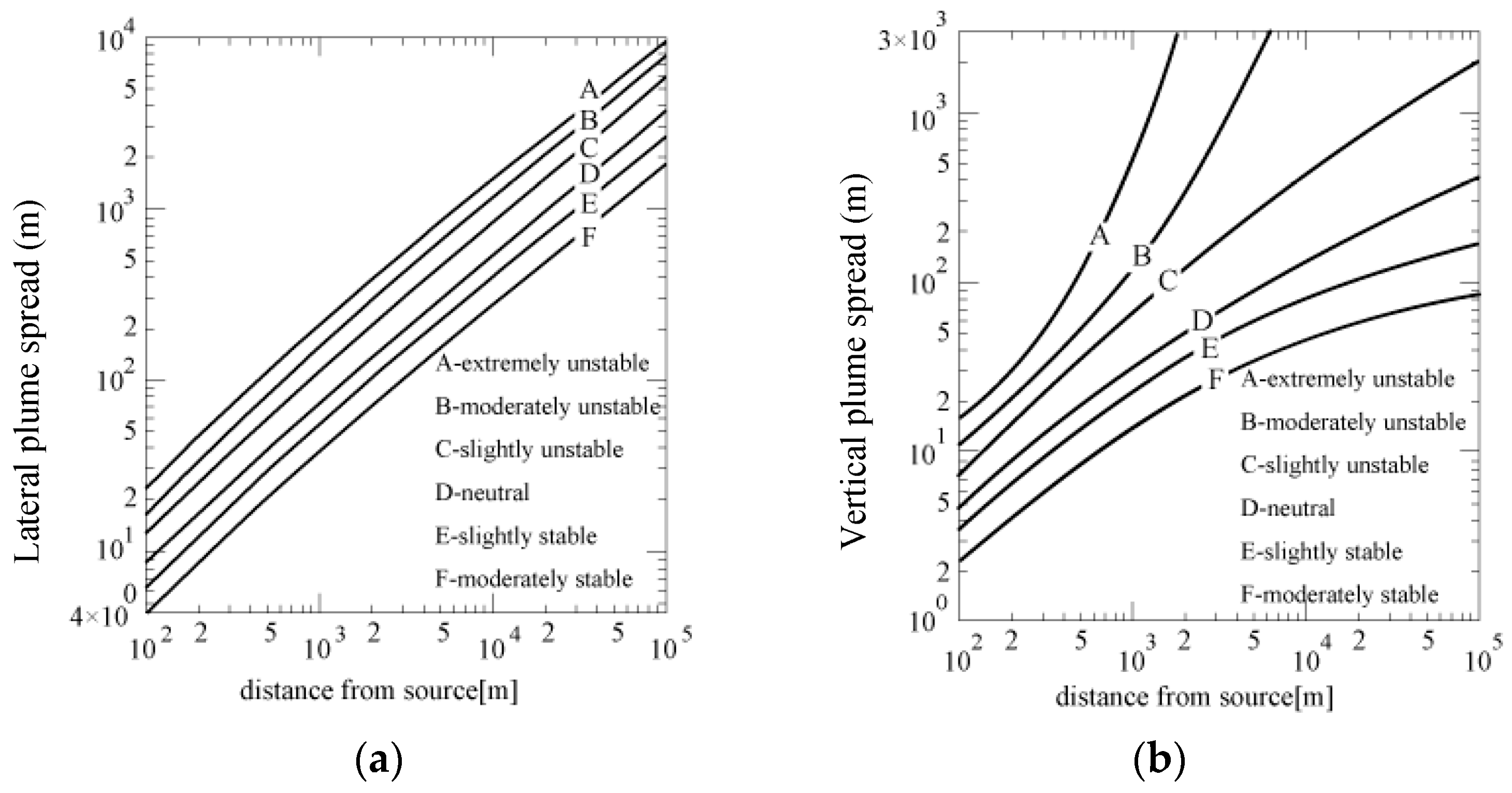
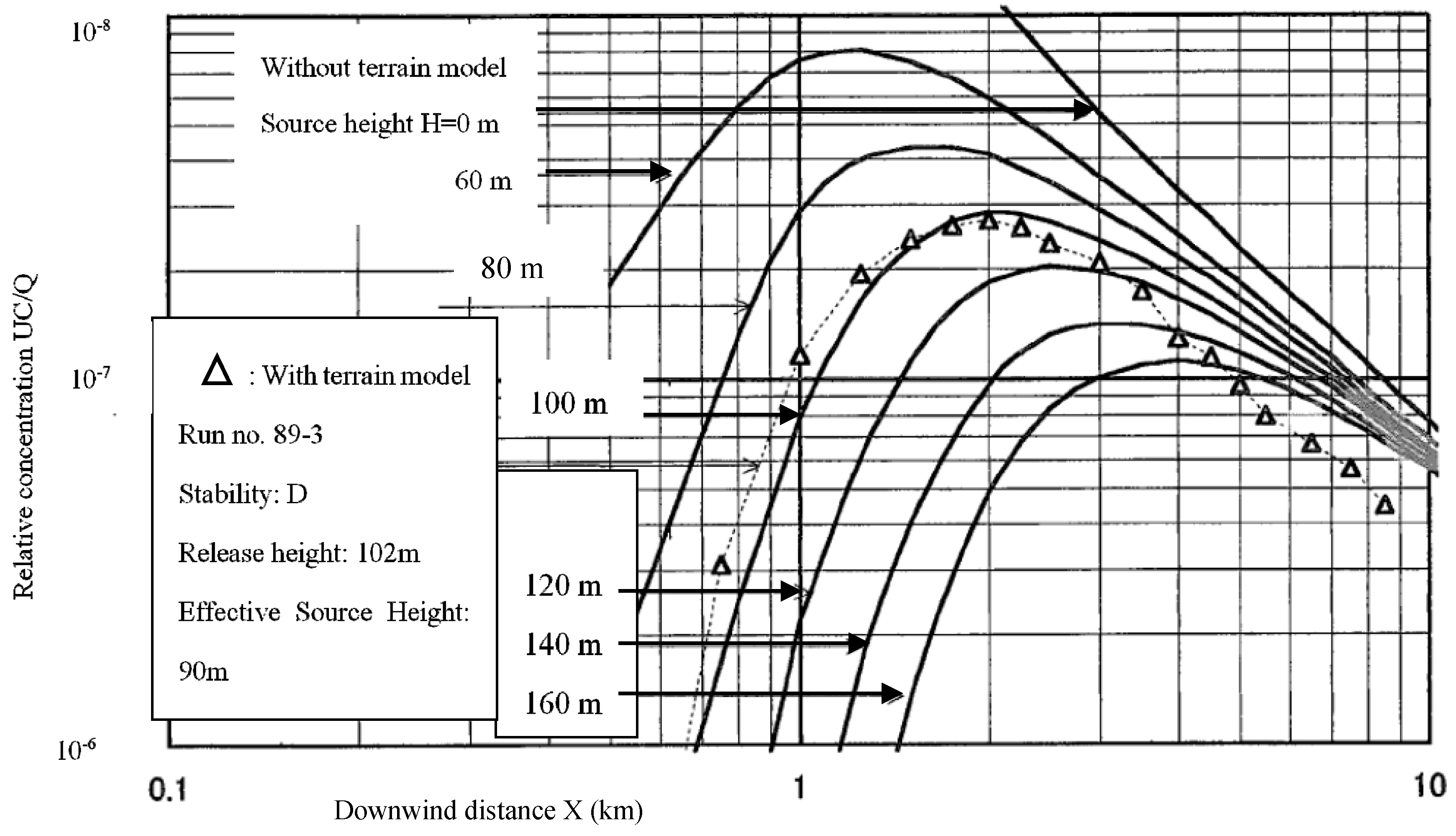
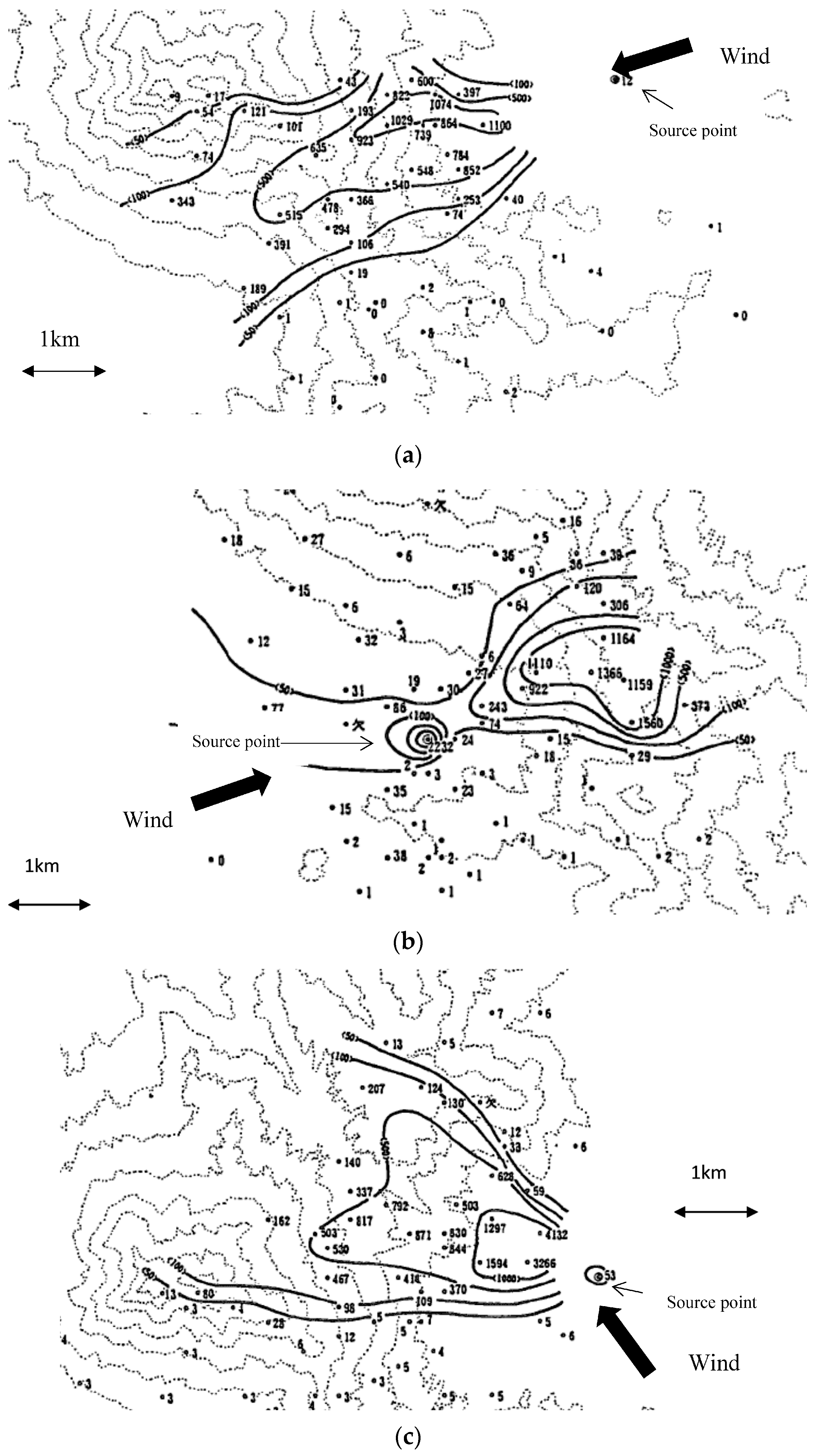
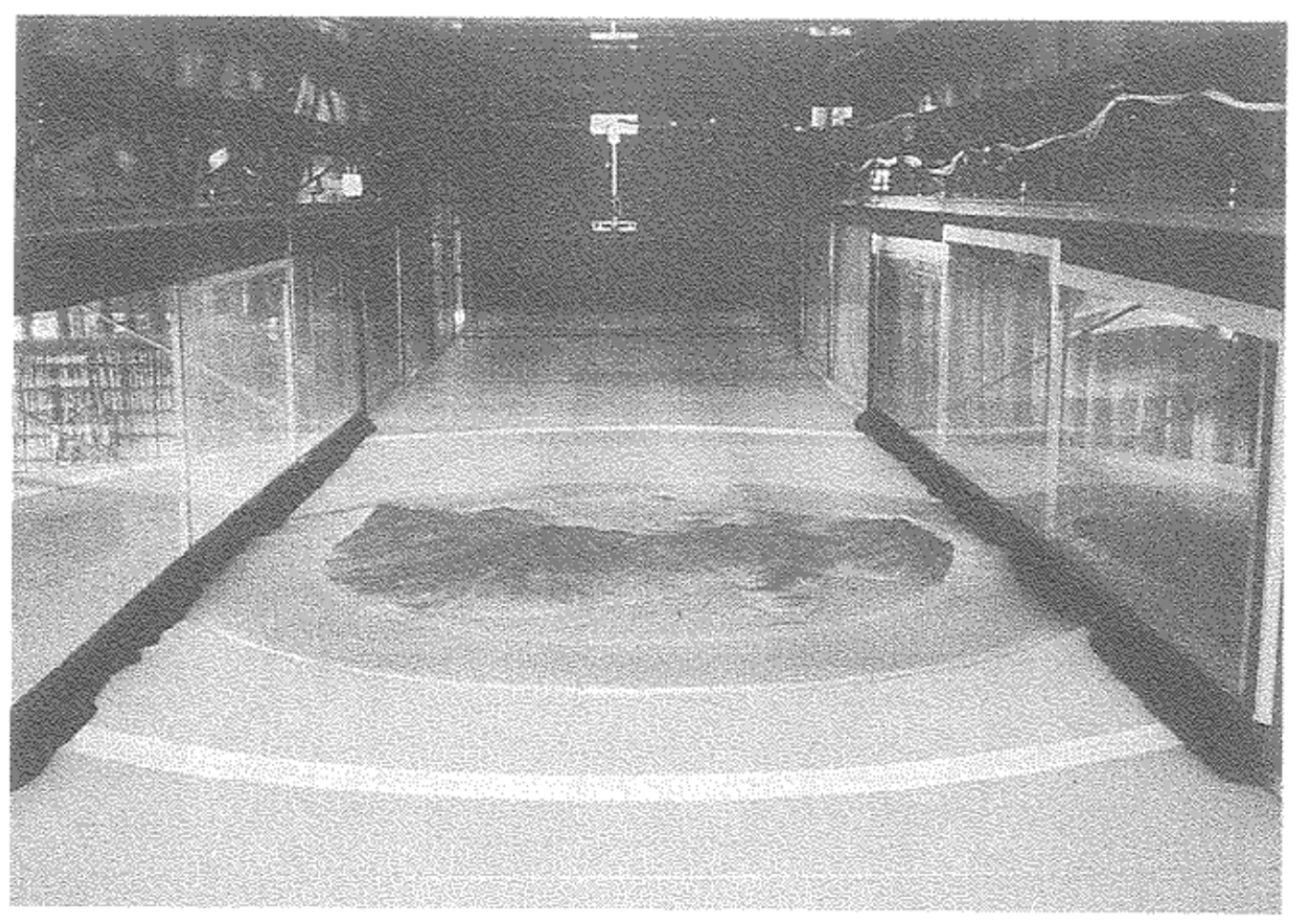
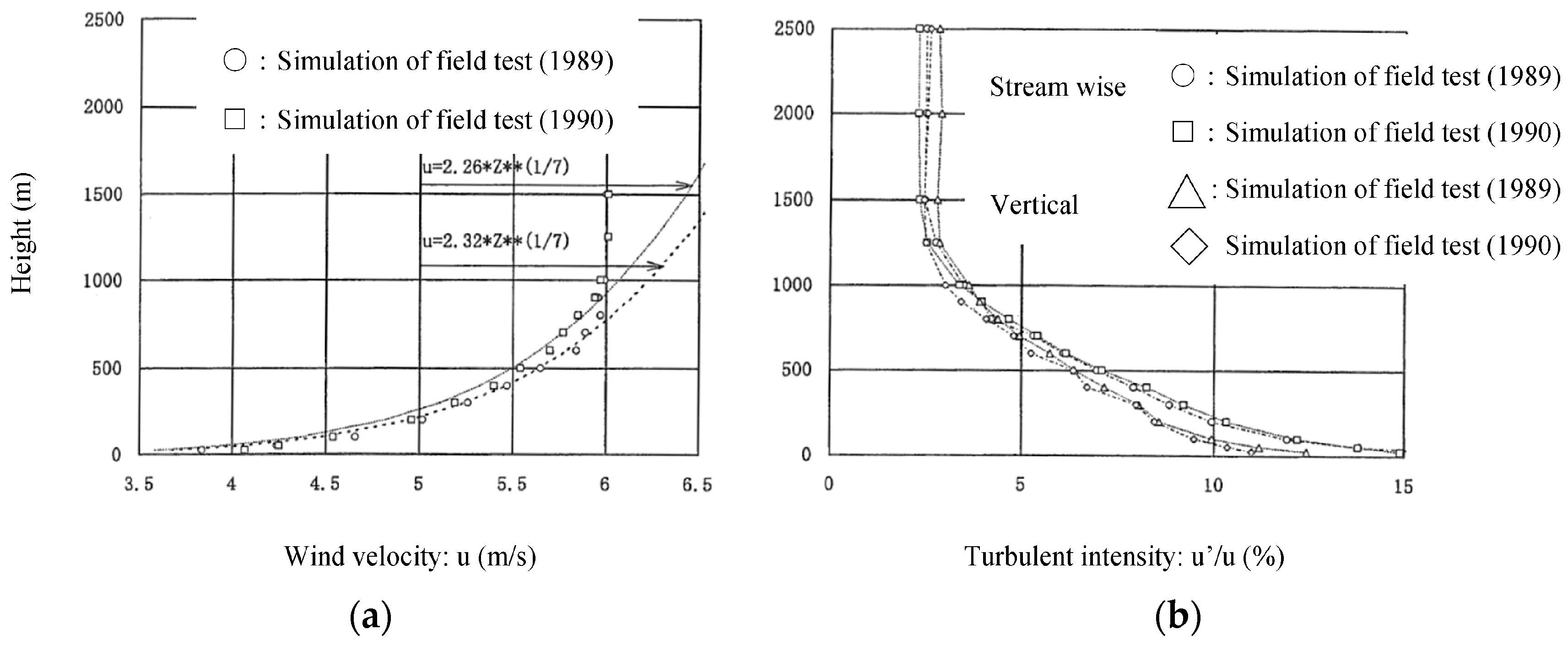
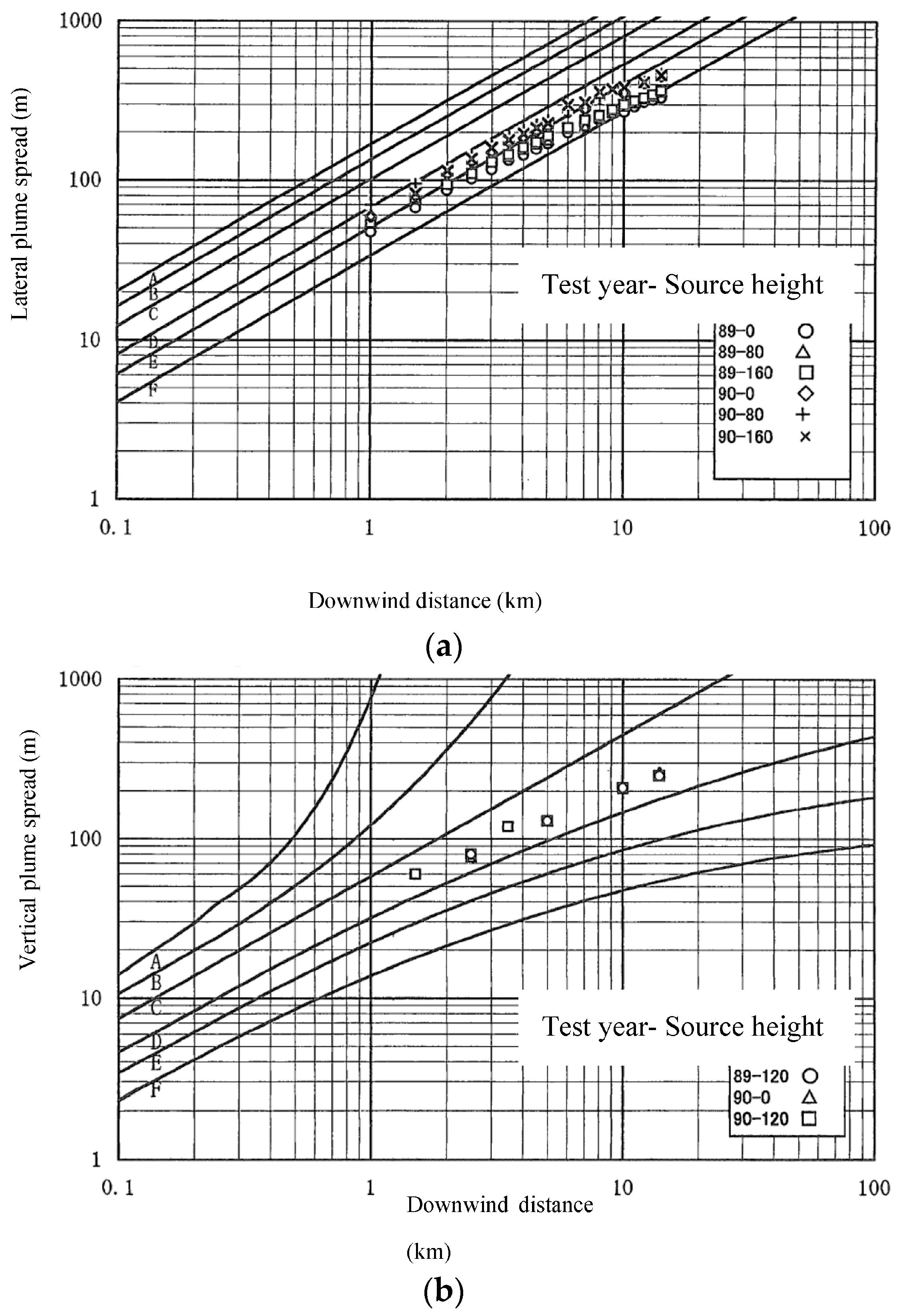

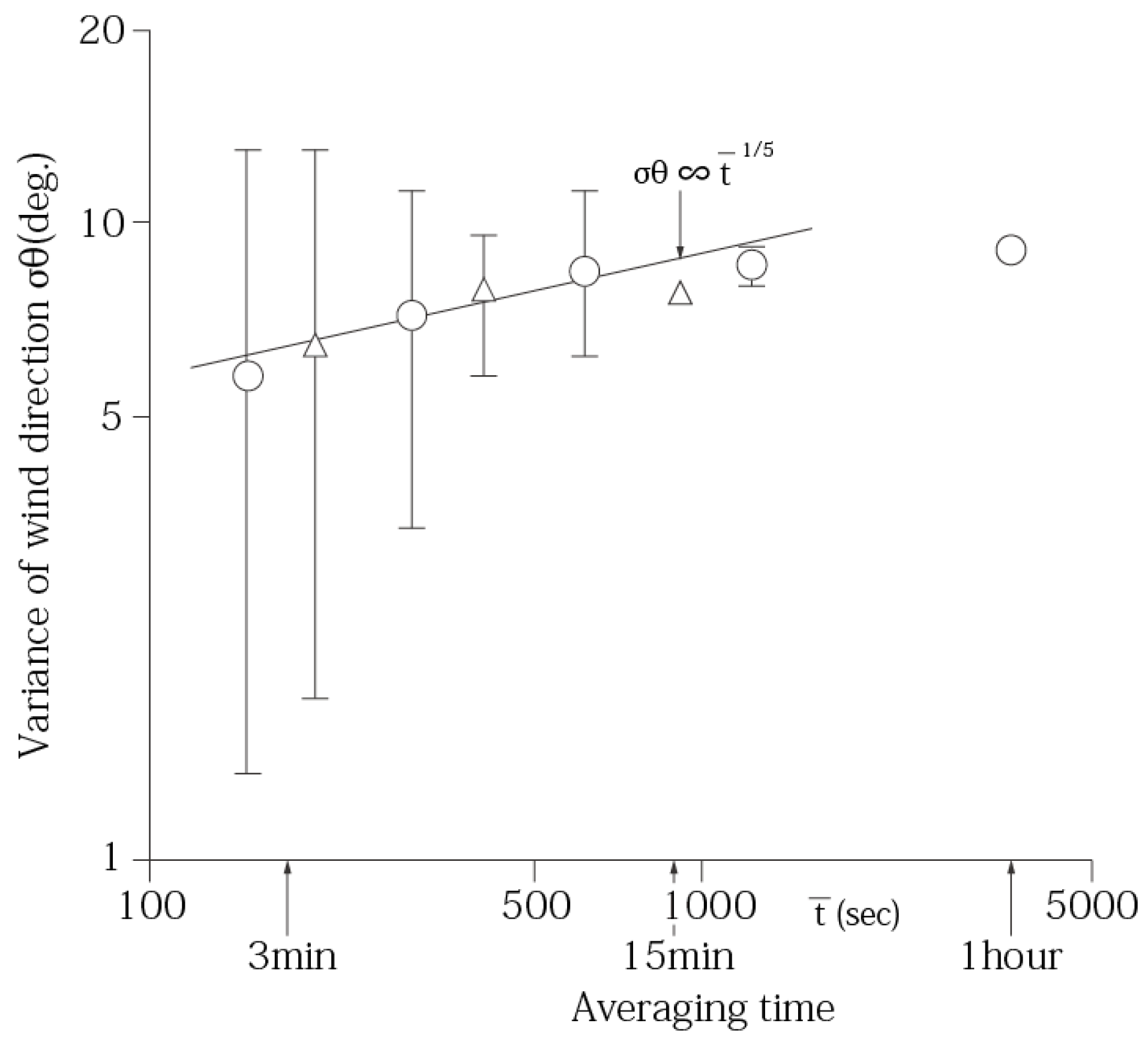
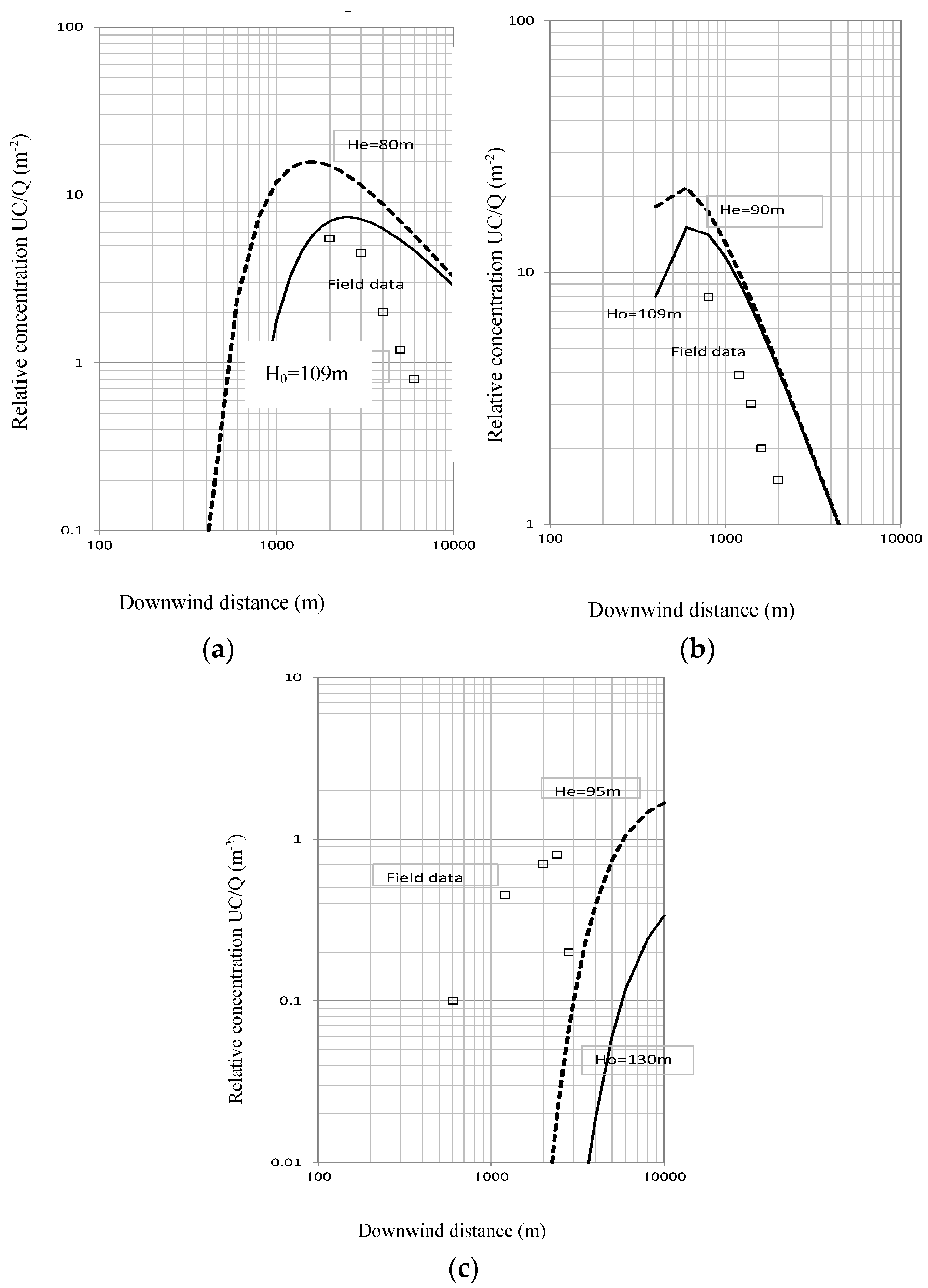
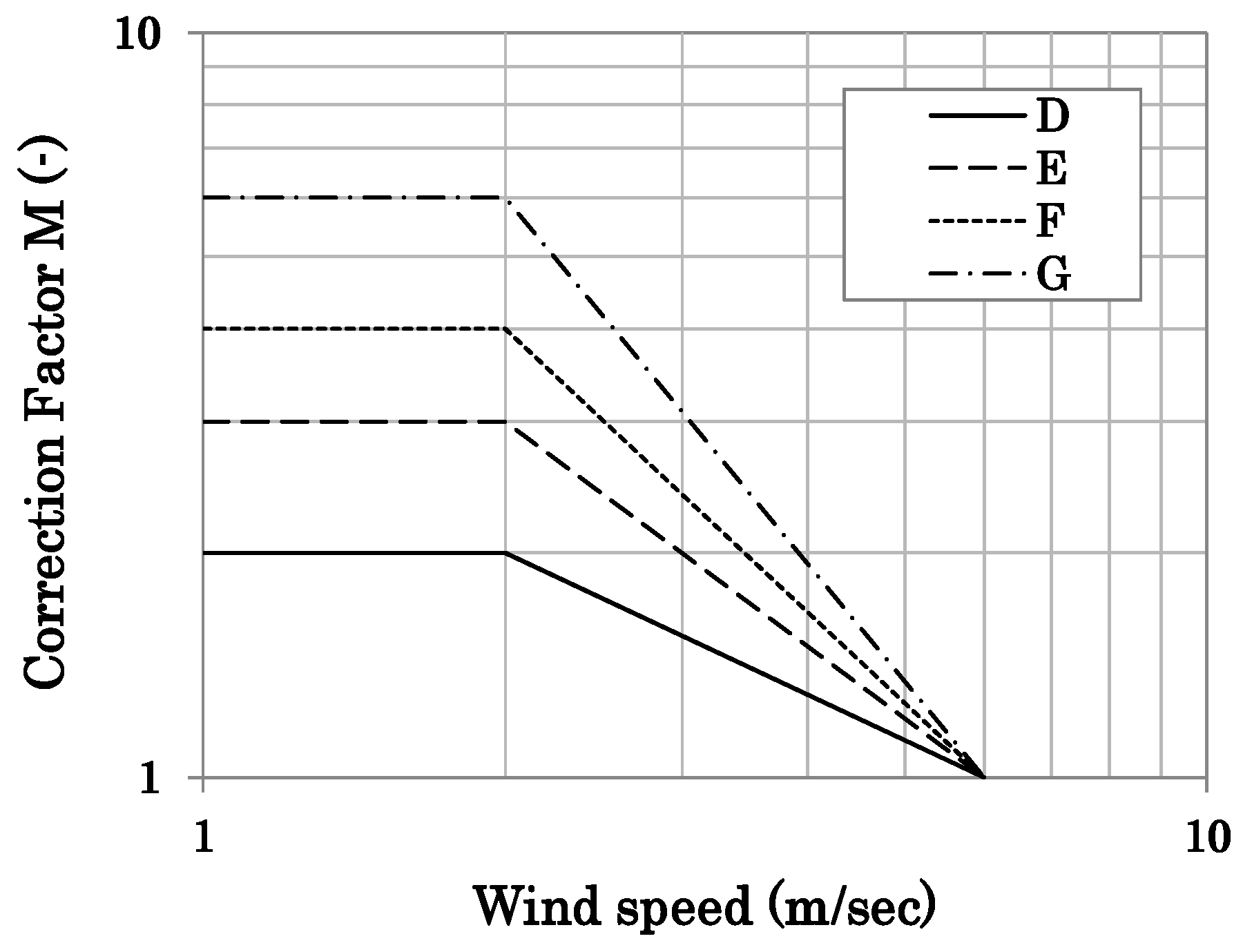


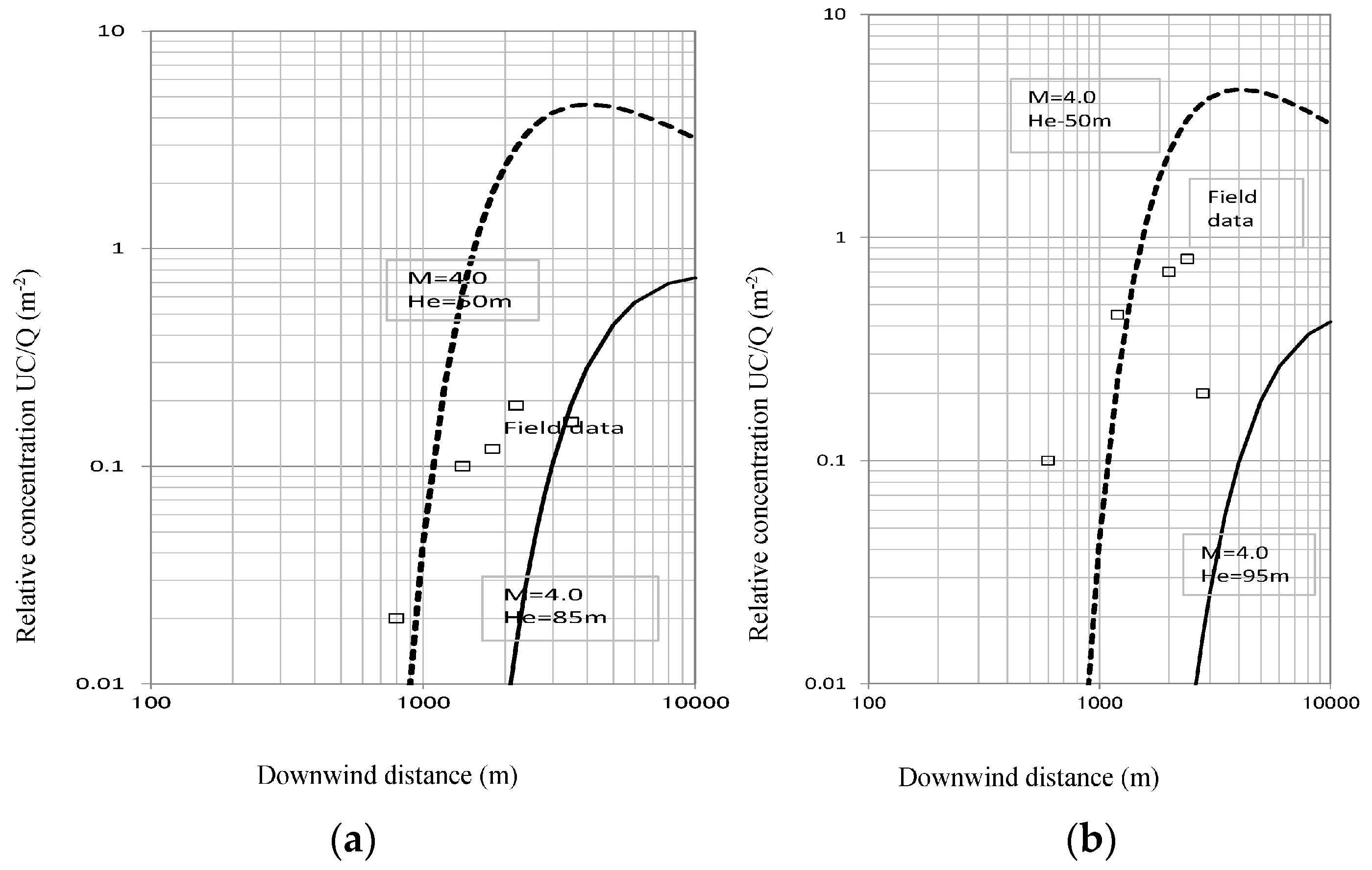
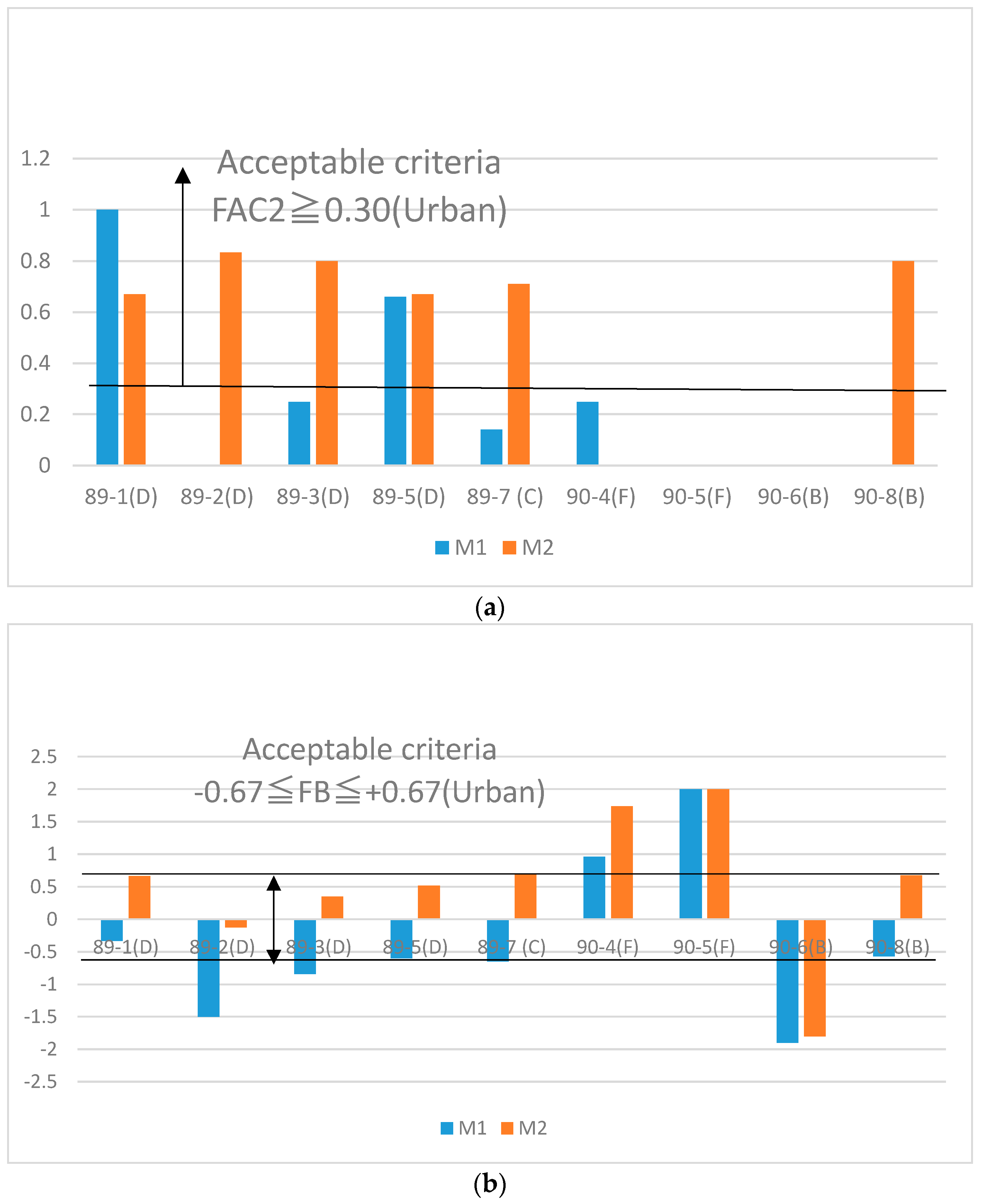
| Run No. | Experimental Condition for the Gas Release and Meteorology Corresponding to | ||||||||
|---|---|---|---|---|---|---|---|---|---|
| Near-Neutral Stability in the Field Experiments | the Non-Neutral Stability in the Field Experiments | ||||||||
| 89-1 | 89-2 | 89-3 | 89-5 | 89-7 | 90-4 | 90-5 | 90-6 | 90-8 | |
| Year/Month/date | 14 November 1989 | 15 November 1989 | 15 November 1989 | 17 November 1989 | 20 November 1989 | 11 November 1990 | 12 November 1990 | 13 November 1990 | 15 November 1990 |
| Sampling time (Japanese standard time) | 14:00–14:30 | 11:00–11:30 | 15:30–16:00 | 12:00–1230 | 15:30–16:00 | 21:00–21:30 | 20:00–20:30 | 14:30–15:00 | 12:00–12:30 |
| Release height (m) | 116 | 89 | 102 | 90 | 119 | 102 | 130 | 107 | 109 |
| Wind speed (m/s) | 4.5 | 5.2 | 4.5 | 3.0 | 3.6 | 1.5 | 0.1 | 2.3 | 2.0 |
| Wind direction (deg.) | 98 | 69 | 76 | 47 | 323 | 324 | 239 | 149 | 134 |
| Atmospheric stability | D | D | D | D | C | F | F | B | B |
| Fluctuation of wind direction (deg.) for sampling time (30 min) | 16.6 | 28.8 | 21.0 | 37.1 | 25.1 | 45.3 | 92.7 | 27.9 | 43.1 |
| Wind Speed (m/s) | Radiation Flux in Daytime (kw/m2) | Radiation Flux in Nighttime (kw/m2) | |||||
|---|---|---|---|---|---|---|---|
| >0.60 | 0.30 ~ 0.60 | 0.15 ~ 0.30 | 0.15> | −0.02> | −0.04 ~ −0.02 | −0.04> | |
| <2 | A | B | B | D | D | F | F |
| 2~3 | B | B | C | D | D | E | F |
| 3~4 | B | C | C | D | D | D | E |
| 4~6 | C | D | D | D | D | D | D |
| 6< | C | D | D | D | D | D | D |
| Tools | Without Terrain | With Terrain | ||
|---|---|---|---|---|
| Neutral | Non-Neutral | Neutral | Non-Neutral | |
| Wind tunnel experiment | Wind Tunnel-1 | Wind Tunnel-2 | ||
 | ||||
| He’ | ||||
| Calculation of Gaussian plume model |  | Result-2 | ||
| Result-1 | ||||
| Run No. | Stability | Lateral Plume Spread (m) | Meandering Factor (M2) | Correction Factor (M1) | ||
|---|---|---|---|---|---|---|
| σy3 | σy30 | σθ30 | ||||
| 89-1 | D | 76.3 | 299.5 | 16.6 | 3.9 | 1.4 |
| 89-2 | D | 76.3 | 508.2 | 28.8 | 6.7 | 1.2 |
| 89-3 | D | 76.3 | 374.2 | 21.0 | 4.9 | 1.4 |
| 89-5 | D | 76.3 | 651.7 | 37.1 | 8.5 | 1.75 |
| 89-7 | C | 104.9 | 450.2 | 25.1 | 4.3 | 1.0 |
| 90-4 | F | 38.1 | 791.2 | 45.3 | 20.7 | 4.0 |
| 90-5 | F | 38.1 | 1617.5 | 92.7 | 42.4 | 4.0 |
| 90-6 | B | 152.6 | 510.0 | 27.9 | 3.3 | 1.0 |
| 90-8 | B | 152.6 | 767.2 | 43.1 | 5.0 | 1.0 |
© 2018 by the authors. Licensee MDPI, Basel, Switzerland. This article is an open access article distributed under the terms and conditions of the Creative Commons Attribution (CC BY) license (http://creativecommons.org/licenses/by/4.0/).
Share and Cite
Oura, M.; Ohba, R.; Robins, A.; Kato, S. Validation Study for an Atmospheric Dispersion Model, Using Effective Source Heights Determined from Wind Tunnel Experiments in Nuclear Safety Analysis. Atmosphere 2018, 9, 111. https://doi.org/10.3390/atmos9030111
Oura M, Ohba R, Robins A, Kato S. Validation Study for an Atmospheric Dispersion Model, Using Effective Source Heights Determined from Wind Tunnel Experiments in Nuclear Safety Analysis. Atmosphere. 2018; 9(3):111. https://doi.org/10.3390/atmos9030111
Chicago/Turabian StyleOura, Masamichi, Ryohji Ohba, Alan Robins, and Shinsuke Kato. 2018. "Validation Study for an Atmospheric Dispersion Model, Using Effective Source Heights Determined from Wind Tunnel Experiments in Nuclear Safety Analysis" Atmosphere 9, no. 3: 111. https://doi.org/10.3390/atmos9030111





